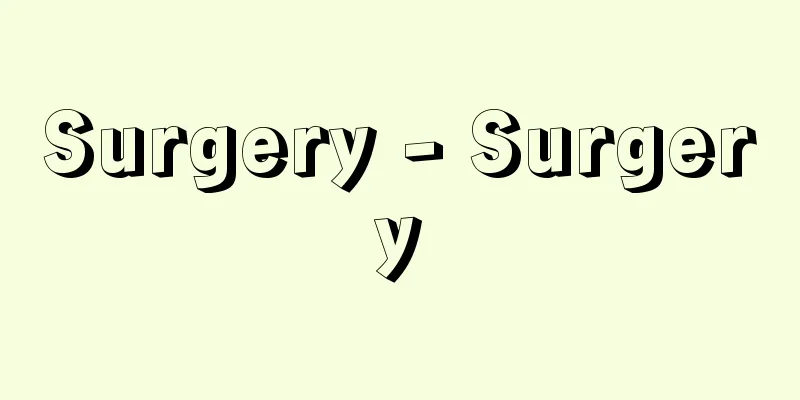Surgery - Surgery

|
It refers to a treatment technique in the surgical field of medicine. The English word "surgery" is a combination of the Greek words for "hand" and "work," and means the same thing as surgery. The English word for surgery is "operation," which means "to manipulate," and indicates the nature of surgical operations. This operation is also abbreviated to "o-pe." Surgery is a general term that refers to all the actions of a surgeon's hands to sew up, cut open, remove, join together, and encase living tissue. [Tatsuyuki Kudo] History of surgeryThe femur of Java man (Pithecanthropus) showed a significant protuberance of the bone, which was probably caused by a prolonged suppurating wound. It is likely that this man wiped away the pus flowing from the wound, applied a cotton-like material made of some kind of fiber to the wound, and covered it with something like a wide leaf. If he broke a leg, he would have covered the injured part with cotton-like material to ease the pain, broken off a suitable tree branch, used one as a splint, and used the other as a walking stick. Either way, it is safe to say that surgery was developed almost simultaneously with the birth of mankind. Specific examples of surgery have already been found in the skulls of the Stone Age, and excavated pre-Inca skulls clearly show traces of artificial craniotomy. Some have several wounds, some old and some new, which suggests the healing process. A closer look at the older wounds shows that there are no signs of suppuration and that they have healed completely. This suggests that humans in the B.C. era already had the technology to confidently perform difficult craniotomy. However, this craniotomy was probably performed for the purpose of creating an opening for the demons living inside the skull of those with "epileptic seizures" to escape, and it is believed that the dura mater (a thick membrane that surrounds and protects the brain, and surgery up to this stage is relatively safe) was not touched. It goes without saying that this is fundamentally different from today's brain surgery. The Babylonian Code of Hammurabi also lists the fees for surgeons, and in China, the famous physician Hua Tuo, who lived at the end of the Eastern Han Dynasty, is said to have performed open abdominal surgery under anesthesia. Surgery was also performed along with human dissection in ancient Egypt, Greece, and Rome. Unfortunately, until the birth of modern surgery at the end of the 19th century, surgery had essentially remained almost unchanged from pre-Inca times, although it had become more complex and diverse. The first reason that can be considered to have caused this long period of stagnation or regression is the spread of superstition, including the influence of religion. The actual damage that so-called superstition has caused to humanity for thousands of years makes us think deeply about the karma of humans, as it was born from the wisdom of the same humans. Surgery in the dark ages of the Middle Ages was brutal. Wounds were always carefully cauterized with a red-hot tool called a rakuten to stop bleeding and prevent suppuration (although in reality it was the opposite). This was unrelated to the patient's social status, and the most they could do was pray for the patient or encourage him with words of encouragement. In Europe at that time, barbers also served as surgeons, and surgeons simply imitated what they saw. After the Renaissance, universities were established in various places, and there were surgeons who were graduates of these universities, but the only advantage they had was that they had knowledge of anatomy. For example, suppuration of a wound was even considered a good sign, since it meant that toxins inside the wound were coming out. In addition, during this time, wars and civil wars were occurring one after another in Europe, and many people were wounded in battle, but most were left on the battlefield and died from wounds festering. Those who were able to receive surgery from a surgeon were considered lucky, but the surgery consisted of amputation of limbs and cauterization of wounds, so how many people managed to survive? The fate of the wounded at that time was truly tragic. Of course, there were those who had doubts about this type of surgery and sought to improve it. One such person was the 16th century French surgeon Paré, who is known as the father of modern surgery. He came up with the idea of cleaning the wound and stopping the bleeding by ligating blood vessels (tying off blood vessels to stop blood circulation) instead of cauterization, and of covering the wound with an ointment made from a mixture of egg yolk and rose oil to protect the wound, which significantly reduced the pain of the wounded. He served as the personal physician to King Henry II and greatly elevated the status of surgeons. However, surgery in this era was limited to wartime surgery and trauma surgery. Full-scale surgery did not begin until the 19th century. With the invention of ether inhalation anesthesia by the American dentist Morton and the introduction of antiseptic methods into surgery by the British surgeon Lister, surgery gradually transformed into a truly harmless, beneficial, scientific, and modern procedure for mankind. [Tatsuyuki Kudo] Operating RoomIt was not until the 20th century that operating rooms were created, where everything in the room is disinfected and surgery is performed while covered in sterilized clothing and gloves, and where operating rooms are designed for this purpose. After Lister's proposal, boiling disinfection of instruments, washing and chemical disinfection of hands, chemical disinfection of the operating area, and sterile drapes gradually became more widespread. However, doctors still only had to take off their coats, and nurses continued to wear their everyday clothes. Gradually, this progressed to the wearing of hats, masks, and rubber gloves, and today's operating rooms were created. The arrival of this state of affairs owes much to the brilliant ideas and efforts of the American brain surgeon Cushing. Modern operating rooms usually have a washroom, an instrument room, and a preparation room, and are equipped with either an X-ray machine that can take pictures during surgery, or a separate specialized room nearby. Other essential requirements include piping for supplying anesthetic gases and oxygen, as well as suction equipment and lighting. Large hospitals do not use a single operating room for multiple purposes, but instead line up 10 to 20 operating rooms for different types of surgery, with centralized instrument rooms, preparation rooms, anesthesia rooms, X-ray rooms (radiology rooms), etc. Also, many hospitals adopt a policy of setting up separate emergency operating rooms to accommodate and treat patients in the event of an unexpected disaster. As a general rule, operating rooms are isolated from other rooms. Usually, the doctor's and nurses' rest room, changing room, preparation room, washroom, etc. are located inside the first door, and the operating room is located inside the second door. In some cases, the preparation room and below are also located inside the second door. The area behind the second door is treated as a sterile room, and wearing clothes other than prepared footwear and surgical underwear is prohibited, and sterilized masks and hats must be worn. The operating room is a sterile room, and the floor is always wiped clean with disinfectant, and an appropriate humidity level is maintained to prevent dust from accumulating. Some places use germicidal lamps to sterilize the air. The room is kept under complete air conditioning, with the appropriate temperature kept at 21-24°C. Nowadays, many surgical instruments are equipped with lighting devices or are electrically powered, and explosion-proof power sources are used for them. In addition, anesthetic oxygen and surgical suction equipment are piped into the operating room with only the connections exposed, while the cylinder room and suction equipment are located far away and centralized to increase efficiency and prevent danger. [Tatsuyuki Kudo] 1. Preparation for SurgeryFirst, the hands of the surgeon and nurse are washed. They are washed twice for 10 minutes using antiseptic soap and a hand brush. Sterile water is used to rinse off the soap. Most faucets are foot-operated. Dry the hands with a sterile towel and then wipe with dilute alcohol to ensure complete disinfection. The nurse assists the surgeon in putting on sterile surgical gowns, caps, and masks. Finally, sterilized rubber gloves are put on and preparations for surgery are complete. The day before the scheduled surgery, the surgeon and anesthesiologist hold a meeting to discuss the patient's general condition, such as the function of the heart and lungs, the surgical method, the planned duration of the surgery, the need for a blood transfusion, the blood type and the planned donor, and the choice of anesthesia method. The surgeon and anesthesiologist also inform the blood center of the required blood type and amount so that they can prepare. The night before, patients are given sleeping pills and sedatives as premedication, and the anesthesiologist may explain the procedure to ease anxiety. On the day of surgery, patients are not allowed to eat or drink, and pentobarbital or pethidine hydrochloride (Opistan) is given as premedication to induce sedation. When the patient enters the operating room, they are sent to the operating room, where they are laid down on the operating table and the anesthesiologist begins preparations for the operation. At this time, the patient is half asleep due to premedication and has little interest in the surroundings. First, the patient is placed in a specific position, and anesthesia is induced through an intravenous injection, resulting in complete loss of consciousness. After intubation, an appropriate amount of anesthetic gas and oxygen are mixed and sent into the lungs along with the breathing movement. When breathing stops, the anesthesiologist presses the gas bag and sends it into the lungs. In this state, iodine tincture or povidone iodine (such as "Isodine") is widely applied to the surgical field, and after 5 minutes it is wiped off with dilute alcohol. This may be repeated twice. The patient's entire body is then covered with a sterile drape to prevent contamination of the surgical field from non-sterile parts. However, the skin incision is left exposed using a drape with an appropriate size hole. If the depth of anesthesia is appropriate and the patient's condition is completely suitable for surgery, the anesthesiologist signals the surgeon to begin the operation. During surgery, the anesthesiologist observes the patient's overall condition and the state of anesthesia, taking notes on each moment, administering blood transfusions depending on the degree of bleeding, and replenishing necessary electrolytes and fluids. If the anesthesiologist determines that the patient is not in a condition suitable for surgery, he or she may request that the surgery be stopped. [Tatsuyuki Kudo] SurgeryToday, there is no part of the body that a surgeon cannot reach with his scalpel, and even the heart, brain, and medulla oblongata can be operated on if necessary. Modern surgery began with three tasks: (1) stopping bleeding, i.e., hemostasis; (2) removing tumors and other diseased tissue; and (3) repairing damaged areas. Later, with the development of specialized fields, the scope of surgical treatment was significantly expanded to include (4) repairing morphological abnormalities or dysfunctional tissues and organs, and (5) complete removal of tumors. Furthermore, unique surgical fields were developed, such as (6) analgesic surgery for persistent pain caused by tumor infiltration and surgery for involuntary movement. Furthermore, with the development of surgical materials, especially plastic tubes and fabrics, (7) drainage of cerebral edema, implantation of substitute blood vessels for blocked arteries, and (8) implantation of a small pacemaker in the chest for impaired heart rhythm became routine. Surgical techniques have also improved significantly, and in addition to stereotactic surgery and microsurgery using an operating microscope, many specialized surgeries are now being performed, such as cryosurgery, which uses a circulating element of liquid nitrogen to freeze tumor tissue, and surgery using laser beams to destroy tumor tissue. Below, we will discuss some representative surgical operations. [Tatsuyuki Kudo] Brain surgeryAlthough surgery to remove brain tumors via craniotomy had been performed since the end of the 19th century, it was Cushing who established brain surgery as a safe and reliable modern procedure. Neurosurgery began with the removal of brain tumors, but nowadays, surgeries for vascular diseases, namely cerebral aneurysms and arteriovenous malformations, have increased dramatically and are becoming more common than brain tumor surgeries. Surgery is also now being performed for hypertensive cerebral hemorrhage. In other words, by removing the hematoma early and controlling the bleeding artery, death can be avoided and sometimes the development of hemiplegia can be prevented. Surgery for brain damage caused by trauma and removal of intracranial hematomas are also important operations, as well as surgery to relieve stubborn pain using brain stereotactic techniques. Although neurosurgery is often thought to be highly risky, the actual surgical mortality rate is low, at just a few percent. [Tatsuyuki Kudo] Thoracic surgeryMost of the surgery is lung surgery. The number of lung tumors is gradually increasing due to the effects of air pollution and the drastic increase in average life expectancy, but surgery may involve removing the tumor along with the lung lobe, or removing the entire lung. In recent years, lobectomy is also being performed for severe bronchiectasis. [Tatsuyuki Kudo] Cardiac surgeryIt can be said that full-scale cardiac surgery began with surgery for patent ductus arteriosus (patent ductus borealis) (1944). Valvular disorders were first treated in 1948. Surgery inside the heart and on large blood vessels such as the aorta was not possible until the practical application of the heart-lung machine (1953), as temporary cessation of circulation was a prerequisite. The widespread use of this machine led to great advances in cardiac surgery and cardiovascular surgery. A variety of surgeries have been devised for myocardial disorders, and in cases of conduction system disorders, it has become possible to maintain normal heartbeat by implanting small pacemakers. In addition, aneurysms in the aorta and other large blood vessels are removed, and substitute blood vessels are implanted, or bypass surgery is also performed. [Tatsuyuki Kudo] Abdominal surgeryAbdominal surgery is the oldest type of surgery. It includes many relatively well-known surgeries, such as removal of cancer of the liver, pancreas, stomach, large intestine, and rectum, as well as relieving intestinal obstruction or removing the obstructed area, appendectomy, and hernia surgery. It is primarily performed by gastrointestinal surgery. [Tatsuyuki Kudo] Transplant surgerySkin transplants (skin grafting) have been performed for a long time and are included in plastic surgery. Autotransplants of other tissues are often successful, but transplants from other people (allografts) are extremely difficult due to the risk of rejection. To eliminate this defense reaction, radiation exposure and immunosuppressant administration are used, and kidney transplants have been quite successful. Heart transplants have also been performed in many cases overseas, with some patients surviving for a long time. In Japan, the first heart transplant was performed in 1968, but various problems, such as the procedures for brain death, were pointed out and progress was slow. However, in 1997, the Organ Transplant Law was enacted, which made it possible to transplant organs from brain-dead people, and three heart transplants were finally performed in 1999 (a total of 65 cases had been performed by the end of March 2009). Other organ transplants performed include liver transplants, lung transplants, heart-lung transplants, pancreas transplants, and small intestine transplants, as well as tissue transplants such as corneal transplants, hematopoietic stem cell transplants (bone marrow transplants, peripheral blood stem cell transplants, umbilical cord blood stem cell transplants), skin transplants, heart valve transplants, and blood vessel transplants. [Tatsuyuki Kudo] "Surgery - Its History and Development" by Hayashi Shiro (1974, NHK Publishing)" ▽ "A Book to Understand Surgery" by Robert Jansson, translated by Nakagawa Haruko and Ueno Yasuko (1995, Marl Publishing)" ▽ "The Operating Room" edited by Shinta Yoshiharu (1995, Medica Publishing)" ▽ "Expert Nurse in Cardiac Surgery" by Tatsuno Katsuhiko, 2nd revised edition (1996, Nanzando)" ▽ "Glossary of Surgical Terms" by the Japanese Surgical Society, 3rd revised edition (1997, Kanehara Publishing)" ▽ "Key Points of Surgery and How to Write Records" by Ogoshi Shohei (1998, Igaku Shoin)" ▽ "The History of Surgery" by W.J. Bishop, translated by Kawamitsu Tomihiro (2005, Jiku-Shoin Publishing)" ▽ "Textbook of Cardiovascular Surgery" by Tatsuno Katsuhiko et al. (2007, Chugai Igaku-sha) [References] | | | | | |Plastic | | | | | | | |Cardiac surgery| | | | | | | | | | | | | | | |Source: Shogakukan Encyclopedia Nipponica About Encyclopedia Nipponica Information | Legend |
|
医学の外科領域における治療手技をいう。外科を意味する英語のsurgeryは、「手」と「働き」を意味するギリシア語を結び付けてできた語であり、手術と同じことを意味している。手術の英語operationは「操作」を意味し、外科手術の実態を示している。このオペレーションを略して単にオペともいう。手術とは、つまり、外科医の手を用いて、生体を縫い合わせ、切り開き、切り取り、また継ぎ合わせ、覆い包むことのすべてを総称する語である。 [工藤達之] 手術の歴史ジャワ原人(ピテカントロプス)の大腿(だいたい)骨には、長期間にわたる化膿創(かのうそう)のために生じたと思われる骨の著しい隆起がみられた。おそらく、この原人は傷から流れ出る膿(うみ)をふき取り、なにかの繊維でつくった綿状のものを傷口に当てて、幅の広い木の葉のようなもので覆ったであろうことが想像される。また下肢の骨折をおこしたような場合も、痛みを和らげる目的で、損傷部位を綿状のもので覆い、適当な木の枝を折って1本は副(そ)え木として使い、他の1本を杖(つえ)として用いたに違いない。いずれにせよ、人類の誕生とほとんど同時に外科が発生していたと考えても間違いない。 具体的な手術例は、石器時代の頭蓋(とうがい)骨にすでにみいだされるし、発掘されたプレ・インカの頭蓋骨には明らかに人為的な開頭手術の痕跡(こんせき)がみられる。なかには、数個の開頭創をもち、しかも治癒過程を物語るように新しいものと古いものとが混じっているものもある。その古いほうの手術創をよくみると、化膿の痕跡がまったくなくて完全治癒が確認されるものがある。つまり、紀元前に人類はすでに困難な開頭手術を自信をもって行うだけの技術をもっていたことがうかがえるわけである。ただし、この開頭手術はおそらく「てんかん発作」をもつ者に対して、頭蓋内にすむ悪魔の出ていく窓口をつくってやるといった目的で行われたもので、硬膜(脳を包んで保護する厚い膜で、ここまでの手術は比較的危険が少ない)には触れていないものと思われる。したがって、今日の脳外科手術とは根本的に異なるものであることはいうまでもない。 また、バビロニアのハムラビ法典には外科医の手術料が記されており、中国でも後漢末の名医華佗(かだ)は、麻酔を施して開腹手術を行ったと伝えられている。なお、古代エジプト、ギリシア、ローマ時代にも、人体解剖とともに、手術も行われていた。しかし残念ながら、19世紀末に近代外科が誕生するまで、手術は、その様相に複雑性と多様性を増したとはいうものの、本質的にはプレ・インカのそれとほとんど変わっていないといってもよい。こうした長期間の停滞もしくは退歩ともみられる事態を招いた理由として、まず考えられるのは、宗教の影響を含めた迷信の流布である。いわゆる迷信が数千年にわたって人類に与えてきた実害は、それが同じ人間の知恵から出たものであるだけに、人間の業(ごう)というものをつくづく考えさせられる。 中世、この暗黒時代の手術は残酷の一語に尽きる。傷口はかならず烙鉄(らくてつ)とよばれる真っ赤に焼けた道具で注意深く焼かれ、止血と化膿防止(実際はその逆なのだが)が図られた。それらは身分とは無関係で、祈祷(きとう)僧が祈ったり声をかけて励ましたりするくらいがせいぜいであった。手術者も、当時のヨーロッパでは理髪師が外科医を兼ねていて、それこそ見よう見まねでやったわけである。ルネサンス以後になると各地に大学ができて、その卒業生という外科医もいたが、解剖学の心得があるのがとりえという程度であった。たとえば、傷の化膿は内部の毒素が出てくるのだからよい徴候であるとさえ考えられた。 またこの時代は、ヨーロッパには戦争や内乱が続発しており、多くの戦傷者が発生したが、大部分は戦場にそのまま放置され、傷の化膿によって死んでいった。外科医の手術が受けられる者は幸運といわなければならなかったが、その手術なるものが手足の切断術に、例の傷口の焼灼(しょうしゃく)であったわけで、幾人が生き延びられたものか。このころの負傷者の運命はまことに悲惨そのものといってよかった。 もちろん、このような外科手術に疑問をもち、その改良を考えた者もいた。近代外科の父ともよばれる16世紀フランスの外科医パレがその一人である。彼は、焼灼のかわりに創面の洗浄と血管の結紮(けっさつ)(血管を縛って血液の循環を止めること)による止血を、また傷口の保護の目的から卵黄とバラ油を混合した軟膏(なんこう)で創面を覆うことを考え、傷者の苦痛を著しく軽減させた。彼は国王アンリ2世の侍医として従軍し、外科医の地位を大いに高めた。 しかし、この時代の外科は戦陣外科であり、外傷外科の範囲にとどまった。本格的な外科手術の発足は19世紀に入ってからである。アメリカの歯科医モートンによるエーテル吸入麻酔の発明、イギリスの外科医リスターによる防腐法の外科への導入などにより、外科手術が人類にとってしだいに真の意味で無害有益な科学的かつ近代的なものに変身する。 [工藤達之] 手術室室内のすべてのものが消毒され、滅菌された衣服や手袋で覆われた状態で手術が行われ、またこの目的に適合するように設計された手術室が誕生したのは、20世紀に入ってからであるといってよい。リスターの提唱以後、器械の煮沸消毒、手の洗浄と薬物消毒、手術部の薬物消毒、滅菌覆布などがしだいに普及してきた。しかし、医師はまだ上衣を脱いだだけ、看護婦は平常衣のままという状態が続いた。これがしだいに帽子、マスク、ゴム手袋を装用するように進んでから、今日の手術室ができあがる。この状態になるまでには、アメリカの脳外科医クッシングの卓抜な着想と努力に負うところが多い。 現代の手術室には、手洗い所や器械室、準備室を付属させ、手術中に撮影できるX線装置を備えるか、近くに別に専門室を設けるのが普通である。このほか、麻酔ガスや酸素の供給用配管および吸引装置、照明装置などを備えることが必須(ひっす)条件となっている。大病院では、一つの手術室を多目的に使うことはせず、手術の種類別に10~20の手術室を並べてつくり、中央集中化された器械室、準備室、麻酔室、レントゲン室(放射線室)などが用意される。また、不時の災害による患者を収容して治療を行う救急手術室を別個に設ける方針をとることも多い。 手術室は原則として他の部室から隔離するのが常識である。普通、医師や看護師の休憩室、着替え室、準備室、手洗い所などを第一扉の内側にとり、手術室を第二扉の内側にとる。準備室以下を第二扉の内側にとる場合もある。第二扉以内は無菌室に準じ、とくに準備した履き物、手術下着以外の服装を禁じ、消毒したマスクおよび帽子を装用する。手術室内は無菌室とし、床を消毒薬でつねに清潔にふき、ほこりのたたないように適度の湿度を保たせる。空気殺菌用に殺菌灯を用いるところもある。室内は完全空気調整下に置かれ、21~24℃の適温に保つ。近来、手術器械には照明装置を付属したもの、あるいは電動式のものが多く、その電源については防爆式のものが用いられ、また麻酔用酸素および手術用吸引装置も、接続部だけを手術室に出して配管し、ボンベ室あるいは吸引装置は遠く離し、中央集約化して効率をあげ、あわせて危険の防止を心がけている。 [工藤達之] 手術の準備まず、術者と看護師の手指の洗浄をする。逆性せっけんと手洗いブラシを用いて2回、10分間の洗浄を行う。せっけんの洗流には滅菌水を使用する。蛇口の栓は足踏み式が多い。滅菌タオルで水気をとり、さらに希アルコールでふいて消毒を完全にする。滅菌手術衣、帽子、マスクを看護師の介助のもとに装用する。最後に滅菌したゴム手袋をはめて、手術準備は完了する。 なお、手術予定日の前日には術者と麻酔医の打合せが行われる。患者の心臓や肺の機能などの一般状態をはじめ、手術法、手術予定時間、輸血の必要性、血液型と供血予定者などのほか、麻酔法の選択などについて打ち合わせるわけで、血液センターに対しても必要血液型や血液量などを通報し、準備させておく。 患者に対しては前夜、前投薬として睡眠薬や鎮静薬の投与をするが、麻酔医が手術について不安を除くために説明することもある。手術当日は禁食とし、前投薬として鎮静入眠の目的でペントバルビタールや塩酸ペチジン(「オピスタン」)などを与えておく。 患者は手術棟に入ると、病衣を清潔な手術用下着とかえて手術室に送られ、手術台上に横たえられると、麻酔医が手術準備を始める。このとき患者は前投薬のため半睡眠状態であり、周囲に対する関心はほとんどない。まず患者は所定の体位をとらされ、静脈注射によって麻酔導入が行われ、完全に意識を失った状態となる。ついで気管内挿管後、適量の麻酔用ガスと酸素が混合されて呼吸運動とともに肺に送り込まれる。呼吸停止の状態下では、麻酔医がガス・バッグを押さえて肺内に送り込む。この状態になって手術野に広くヨードチンキあるいはポビドンヨード(「イソジン」など)を塗布し、5分後これを希アルコールでふき取る。これを二度繰り返す場合もある。それから滅菌した覆布で患者の全身を覆い、非消毒部から手術野への汚染を防ぐ。ただし皮切部は、適当な大きさに穴があいている覆布を用いて露出させておく。麻酔の深さが適当で、患者の状態が完全に手術に適した状態にあれば、麻酔医が術者に合図して手術が開始される。 麻酔医は手術中、患者の全身状態、麻酔の状態などを観察し、刻々その記録をとるとともに、出血の状態に応じて輸血を行い、また必要な電解質や水分も補充する。患者が手術に適さない状態にあると麻酔医が判断すれば、手術の中止を要求することもある。 [工藤達之] 外科手術現在、外科医のメスの到達が不可能な部位はなく、心臓の中でも、脳や延髄でも、必要があれば手術の対象となる。 近代手術はその当初、(1)出血を止めること、すなわち止血、(2)腫瘍(しゅよう)そのほか不良組織を切除すること、(3)破損部位の修理をすること、以上三つから発足した。その後、専門分科の進歩により、(4)形態異常の修復、あるいは機能が不良になった組織器官の修復、(5)腫瘍の完全摘除、が行われるようになって、手術治療の適応範囲が著しく広げられた。さらに、(6)腫瘍の浸潤に由来する頑固な痛みに対する鎮痛手術、あるいは不随意運動に対する手術など、特異な手術領域も開発された。また、手術材料、とくにプラスチックチューブおよび布類の開発によって、(7)脳水腫の排水手術、あるいは閉塞(へいそく)動脈に対する代用血管の埋め込み、さらに、(8)律動機能が障害された心臓に対して小型ペースメーカーを胸部に埋め込む手術などが日常的に行われるようになった。 なお、手術技術の改良も著しく、脳定位手術、手術顕微鏡を用いるマイクロサージェリーなどのほか、腫瘍組織を破壊する目的からの、液体窒素の循環するエレメントによる凍結利用のクライオサージェリーや、レーザー光線を応用する手術など、数多くの特殊手術が行われている。 以下、外科における代表的な手術について述べる。 [工藤達之] 脳手術19世紀末から開頭して脳腫瘍を除去する手術が行われていたが、安全確実な近代手術として脳手術を確立したのはクッシングである。 脳外科は脳腫瘍の摘出に始まったが、現在では血管疾患、すなわち脳動脈瘤(りゅう)、動静脈奇形の手術が激増して、脳腫瘍手術より多くなりつつある。また、高血圧性脳出血についても手術が行われるようになった。すなわち、早期に血腫を除去し、出血動脈に止血操作を施して死を免れさせ、ときには片麻痺(へんまひ)の発生も防げる。なお、外傷による脳損傷、頭蓋内血腫除去手術も重要な手術であり、そのほか、脳定位法による頑痛除去手術などがある。脳外科の手術は危険率が高いように思われがちであるが、実際上の手術死亡率は低く、数パーセントを出ない。 [工藤達之] 胸部手術肺外科の手術が大部分を占める。肺の腫瘍は、空気の汚染の影響や平均寿命の大幅な延長などにより、しだいに増加しているが、手術は肺葉ごと腫瘍を除去する場合と、片肺全部を切除する場合とがある。近年、重症の気管支拡張症でも肺葉切除が行われる。 [工藤達之] 心臓手術本格的な心臓手術は、動脈管開存症(ボタロー管開存症)に対する手術(1944)に始まるといってよい。弁膜の故障に対しては1948年に初めて着手された。心臓内部の手術と大動脈などの大血管の手術は、人工心肺装置が実用化(1953)されるまではできなかった。一時的な循環停止が前提条件であったからである。この装置の普及により、心臓外科、心臓血管外科が大いに進展した。心筋障害に対しては各種の手術がくふうされており、伝導系の故障には小型ペースメーカーの埋め込みによって心臓の正常拍動を維持することが可能となった。また大動脈その他の大血管の動脈瘤の切除をはじめ、代用血管の植え込み、あるいはバイパス手術なども行われている。 [工藤達之] 腹部手術腹部手術はもっとも古くから行われた手術である。肝臓、膵臓(すいぞう)、胃、大腸、直腸などの癌(がん)の切除をはじめ、腸閉塞の解除あるいは閉塞部の切除、虫垂切除手術、ヘルニア手術など、比較的一般にも知られている手術が多い。おもに消化器外科で行われる手術である。 [工藤達之] 移植手術皮膚の移植(植皮術)は古くから行われており、形成手術に含まれる。そのほかの組織の移植手術でも自家移植は成功する場合が多いが、他人からの移植(同種移植)は拒絶反応があるため、きわめて困難である。この生体の防衛反応を除くために放射線照射や免疫抑制剤の投与などが行われ、腎臓(じんぞう)移植はかなりの成績を収めている。心臓移植も外国ではすでにかなりの症例に移植が行われ、長期生存例もある。日本では、1968年(昭和43)に初の心臓移植が行われたが、脳死手続などさまざまな問題が指摘され進展しなかった。しかし、1997年(平成9)に脳死者からの臓器移植を可能とする「臓器移植法」が制定され、1999年にようやく3例の心臓移植が行われた(2009年3月末までに計65例施行)。そのほか肝臓移植、肺移植、心肺移植、膵臓移植、小腸移植などの臓器移植や、角膜移植、造血幹細胞移植(骨髄移植、末梢血幹細胞移植、臍帯血幹細胞移植)、皮膚移植、心臓弁移植、血管移植などの組織移植も行われている。 [工藤達之] 『林四郎著『手術――その歴史と展開』(1974・日本放送出版協会)』▽『ロバート・ヤンソン著、中川治子・上野安子訳『手術がわかる本』(1995・マール社)』▽『新太喜治編『手術室』(1995・メディカ出版)』▽『龍野勝彦著『心臓外科エキスパートナーシング』改訂第2版(1996・南江堂)』▽『日本外科学会著『外科手術用語集』改訂第3版(1997・金原出版)』▽『小越章平著『手術のポイントと記録の書き方』(1998・医学書院)』▽『W・J・ビショップ著、川満富裕訳『外科の歴史』(2005・時空出版)』▽『龍野勝彦他著『心臓血管外科テキスト』(2007・中外医学社)』 [参照項目] | | | | | | | | | | | | | | | | | | | | | | | | | | | | | |出典 小学館 日本大百科全書(ニッポニカ)日本大百科全書(ニッポニカ)について 情報 | 凡例 |
>>: Master-servant relationship
Recommend
imperial
…But the credit note was only worth 93-99% of the...
European Parliament - YOROPPAGIGAI (English spelling) European Parliament
One of the main institutions of the EU (European ...
Grétry, André-Ernest-Modeste
Born: February 11, 1741 in Liège Died September 24...
Hakozaki Shrine
Located in Hakozaki-cho, Higashi-ku, Fukuoka City...
Takatori ware
A representative early modern pottery kiln in Fuk...
Geissler burette (English spelling)
...A glass tube with a volumetric scale, with a g...
Zenkoji earthquake
The earthquake occurred at around 9:00-10:00 pm o...
Atrophic Rhinitis
[What kind of disease is it?] This is a disease in...
Temperature-Salinity Chart - Ondoenbunzu
…However, compared to air masses, the characteris...
Rhododendron mucronatum (English spelling) Rhododendronmucronatum
…[Yoshiharu Iijima]. … *Some of the terminology t...
Female labor - Joseiroudou
It usually refers to women's employed labor (...
Rock moss - Rock moss
A large, beautiful species of the family Musciacea...
Henri Michaux
French poet and painter. Born in Belgium, he beca...
Cold-dried powder - Kanzarashiko
Please see the "Shiratama Flour" page. ...
Japan Children's Protection Association - Nihon Kodomo wo Mamorukai
The group was formed in May 1952, triggered by a c...









